Chi Cygni still bright. Chi (χ) Cygni, one of the brightest red long-period variable stars, is having an unusually bright maximum. It reached magnitude 3.8 earlier in May and is just beginning to fade, still very plain to the naked eye. Look for it adding to the bottom part of the shaft of the Northern Cross, between Eta (η) and Beta (β) Cygni. Cygnus is reasonably well up in the east by about 10 p.m., with the Northern Cross lying on its side. Comparison-star chart, and two-year light curve up to the present courtesy AAVSO.
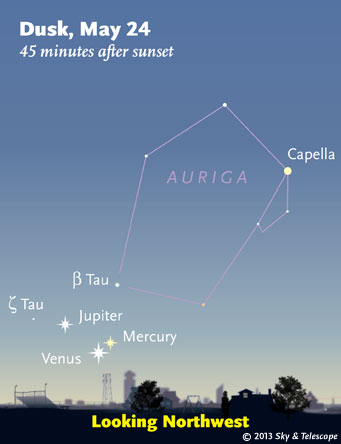
Closer and closer....
Sky & Telescope magazine
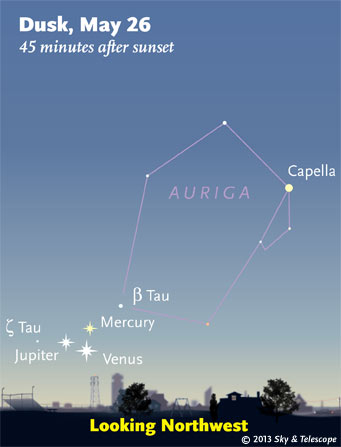
Sky & Telescope magazine
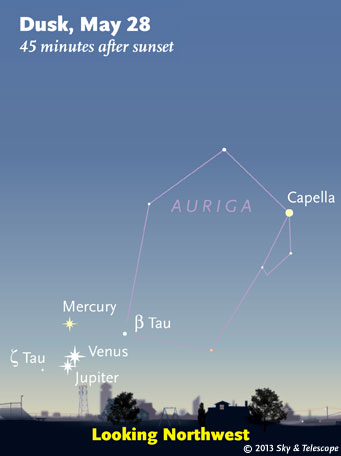
Sky & Telescope magazine
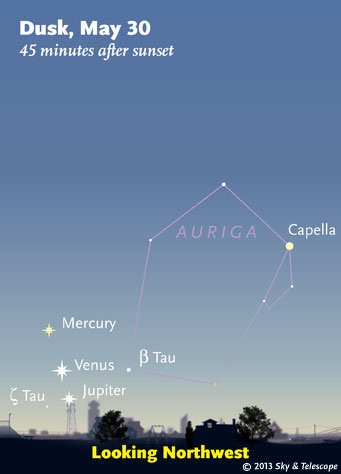
The bright planets in these scenes are plain to the naked eye, but the fainter stars may be hard or impossible to see in bright twilight. The scenes are about three fist-widths at arm's length wide. They're drawn for the middle of North America but will be good enough throughout the world's mid-northern latitudes. For the scene every day, plus high-res versions for print use, see our press release. Pass them on!
Sky & Telescope magazine
Friday, May 24
For sky scenes showing the group's progress every day through May 31st — which you are welcome to republish elsewhere with credit (the video too!) — see our press release. It also has hi-res versions of the scenes.
Saturday, May 25
Sunday, May 26
Monday, May 27
Tuesday, May 28
Wednesday, May 29
Thursday, May 30
Friday, May 31
Saturday, June 1
Want to become a better amateur astronomer? Learn your way around the constellations. They're the key to locating everything fainter and deeper to hunt with binoculars or a telescope.
For an easy-to-use constellation guide covering the whole evening sky, use the big monthly map in the center of each issue of Sky & Telescope, the essential guide to astronomy. Or download our free Getting Started in Astronomy booklet (which only has bimonthly maps).

The Pocket Sky Atlas plots 30,796 stars to magnitude 7.6 — which may sound like a lot, but that's less than one star in an entire telescopic field of view, on average. By comparison, Sky Atlas 2000.0 plots 81,312 stars to magnitude 8.5, typically one or two stars per telescopic field. Both atlases include many hundreds of deep-sky targets — galaxies, star clusters, and nebulae — to hunt among the stars.
Sky & Telescope
Once you get a telescope, to put it to good use you'll need a detailed, large-scale sky atlas (set of charts). The standards are the little Pocket Sky Atlas, which shows stars to magnitude 7.6; the larger and deeper Sky Atlas 2000.0 (stars to magnitude 8.5); and the even larger Uranometria 2000.0 (stars to magnitude 9.75). And read how to use sky charts with a telescope.
You'll also want a good deep-sky guidebook, such as Sue French's Deep-Sky Wonders collection (which includes its own charts), Sky Atlas 2000.0 Companion by Strong and Sinnott, the bigger Night Sky Observer's Guide by Kepple and Sanner, or the beloved if dated Burnham's Celestial Handbook.
Can a computerized telescope replace charts? Not for beginners, I don't think, and not on mounts and tripods that are less than top-quality mechanically (able to point with better than 0.2° repeatability). As Terence Dickinson and Alan Dyer say in their invaluable Backyard Astronomer's Guide, "A full appreciation of the universe cannot come without developing the skills to find things in the sky and understanding how the sky works. This knowledge comes only by spending time under the stars with star maps in hand."
This Week's Planet Roundup
Mercury, Venus, and Jupiter are bunched together low in the afterglow of sunset, forming a new configuration each evening. They're magnitudes –1, –4, and –2, respectively. From the 24th through 29th the three form a "trio," fitting in a circle 5° in diameter. They're bunched most tightly, fitting in a 2½° circle, on the evening of the 26th.
Mercury and Venus appear closest together, just under 1½° apart, on the 23rd and 24th. Venus and Jupiter are closest, 1° apart, on the 28th.
See our article The May-June Planet Dance. For day-by-day sky scenes through the 31st, which you are welcome to republish elsewhere with credit (the video too!), see our press release.
Mars is hidden behind the glare of the Sun.
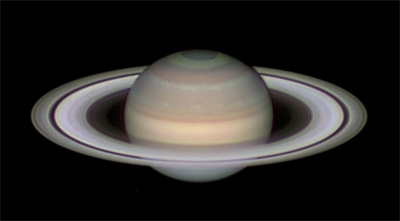
"Here is an image of Saturn taken on April 20th from Mt. Olympus, Cyprus (1950m altitude) under excellent observing conditions," writes Damian Peach. "Probably the best view I've had of the planet in the last few years. Periods of extremely steady seeing prevailed and allowed a very clear view of the planet and rings. A really memorable and enjoyable night on Cyprus's highest peak."
North is up. Note the north polar hexagon. The thin whitish zone at mid-northern latitudes is the remains of the great storm of 2010–11. Several brightness minima can be seen across the ring system. Peach used a 14-inch Celestron Schmidt-Cassegrain telescope.
Saturn (magnitude +0.2, in Libra) glows in the southeast during twilight, with Spica to its upper right and Arcturus twice as far to its upper left. It's highest in the south not long after dark.
In a telescope, Saturn's rings are nicely tilted 18° from our line of sight. See our guide "Scrutinizing Saturn" in the May Sky & Telescope, page 50, or the shorter version online. And identify Saturn's many moons at any time and date with our SaturnMoons utility or handier app.
Uranus (magnitude 5.9, in Pisces) is low in the east at the beginning of dawn.
Neptune (magnitude 7.9, in Aquarius) is in the southeast just before dawn begins.
All descriptions that relate to your horizon — including the words up, down, right, and left — are written for the world's mid-northern latitudes. Descriptions that also depend on longitude (mainly Moon positions) are for North America. Eastern Daylight Time (EDT) equals Universal Time (also known as UT, UTC, or GMT) minus 4 hours.
Like This Week's Sky at a Glance? Watch our SkyWeek TV short, also playing on PBS.
To be sure to get the current Sky at a Glance, bookmark this URL:
http://SkyandTelescope.com/observing/ataglance?1=1
If pictures fail to load, refresh the page. If they still fail to load, change the 1 at the end of the URL to any other character and try again.
 0
0
Comments
You must be logged in to post a comment.